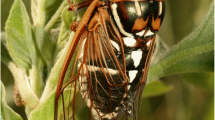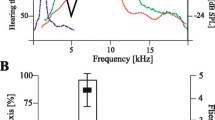Abstract
Some groups of tachinid flies deposit mobile first-instar larvae (or planidia) on or near their host. Flies within one such group, the tribe Ormiini, parasitize singing species of ensiferan Orthoptera and use sound for long distance host location. However, what induces tachinids to larviposit and whether planidia use any cues actively to locate their host remains poorly known. This paper examines the larviposition and planidial behavior of the ormiine Homotrixa alleni in relation to its bushcricket host, Sciarasaga quadrata. Sound alone was sufficient to elicit larviposition in gravid female H. alleni, where females arriving at an arena placed over a speaker broadcasting host song deposited an equal number of planidia in the presence or absence of a silent S. quadrata. Flies were observed to larviposit by forcibly expelling planidia up to 6 cm in a forward direction from the fly, with less than half of the trials with a host present resulting in physical contact between the host and the fly. In the host's absence, flies walked around the arena significantly more often, remained on the arena for the experimental duration (10 min), and changed orientation frequently. In the host's presence, flies generally maintained a position facing the host, stayed in the quadrant of first approach, and typically flew off the arena within 2 min of arrival. When the oncoming fly approached a forward facing host, more planidia were found in the arena's center (i.e., closer to the host) than in the no-host or rearward-facing host treatment. Planidia experimentally placed on a circular arena averaged 1 cm of movement in 15 min but none of the following cues–host song, host song with song-vibration transmission, a silent host, and a silent host with host movement-vibration transmission–significantly affected the direction or distance planidia traveled. At 20 ± 1°C, over half of the planidia died within 1 h and all died within 2 h of deposition. The significance of these results in relation to reproductive strategies and parasitism is discussed.
Similar content being viewed by others
REFERENCES
Adamo, S. A., Robert, D., Perez, J., and Hoy, R. R. (1995). The response of an insect parasitoid, Ormia ochracea (Tachinidae), to the uncertainty of larval success during infestation. Behav. Ecol. Sociobiol. 36: 111–118.
Allen, G. R. (1995a). The biology of the phonotactic parasitoid, Homotrixa sp. (Diptera, Tachinidae), and its impact on the survival of male Sciarasaga quadrata (Orthoptera, Tettigoniidae) in the field. Ecol. Entomol. 20: 103–110.
Allen, G. R. (1995b). The calling behaviour and spatial distribution of male busherickets (Sciarasaga quadrata) and their relationship to parasitism by acoustically orienting tachinid flies. Ecol. Entomol. 20: 303–310.
Allen, G. R. (1998). Diel calling activity and field survival of the bushcricket Sciarasaga quadrata (Orthoptera: Tettigoniidae): A role for sound-locating parasitic flies? Ethology 104: 645–660.
Allen, G. R., and Pape, T. (1996). Description of female and biology of Blaesoxipha ragg (Diptera: Sarcophagidae): A parasitoid of Sciarasaga quadrata Rentz (Orthoptera: Tettigoniidae) in Western Australia. Aust. J. Entomol. 35: 147–151.
Askew, R. R. (1971). Parasitic Insects, Elsevier, New York.
Barraclough, D. A., and Allen, G. R. (1996). Two new species of Homotrixa Villeneuve (Diptera: Tachinidae: Ormiini) from Southwestern Australia, with data on biology and ecology. Aust. J. Entomol. 35: 135–145.
Belshaw, R. (1993). Tachinid Flies, Diptera: Tachinidae, Royal Entomological Society of London, London.
Belshaw, R. (1994). Life history characteristics of Tachinidae (Diptera) and their effect on polyphagy. In Hawkins, B. A., and Sheehan, W. (eds.), Parasitoid Community Ecology, Oxford University Press, Oxford, pp. 145–162.
Cade, W. H. (1975). Acoustically orienting parasitoids: fly phonotaxis to cricket song. Science 190: 1312–1313.
Campbell, D. J., and Forest, J. (1987). A cricket-song simulator using the 68705 single-chip micro-computer. Behav. Res. Methods Instr. Comput. 19: 26–29.
Cantrell, B. K. (1988). The comparative morphology of the male and female postabdomen of the Australian Tachinidae (Diptera), with descriptions of some first instar larvae and pupae. Invertebr. Traxon. 2: 81–221.
Cantrell, B. K., and Crosskey, R. W. (1989). Family Tachinidae. In Evenhuis, N. L. (ed.), Catalog of the Diptera of the Australasian and Oceanian Regions, Bishop Museum Press and E. J. Brill., Honolulu and Leiden, pp. 733–784.
Charnov, E. L. (1993). Life History Invariants, Oxford University Press, Oxford.
Feener, D. H., Jr., and Brown, B. V. (1997). Diptera as parasitoids. Annu. Rev. Entomol. 42: 73–97.
Fowler, H. G. (1987). Field behavior of Euphasiopteryx depleta (Diptera: Tachinidae): Phonotactically orienting parasitoids of mole crickets (Orthoptera: Gryllotalpidae: Scapteriscus). J. N.Y. Entomol. Soc. 95: 474–480.
Fowler, H. G., and Martini, A. M. Z. (1993). Larval dispersion of Ormia depleta (Towns.) (Dipt., Tachinidae). J. Appl. Entomol. 115: 107–110.
Godfray, H. C. J. (1994). Parasitoids: Behavioral and Evolutionary Ecology, Princeton University Press, Princeton, NJ.
Hunt, J., and Allen, G. R. (1998). Fluctuating asymmetry, call structure and the risk of attack from phonotactic parasitoids in the bushcricket Sciarasaga quadrata (Orthoptera: Tettigonidae). Oecologia 11: 356–364.
Monteith, L. G. (1956). Influence of host movement on selection of hosts by Drino bohemica Mesn. as determined in an olfactometer. Can. Entomol. 88: 583–586.
Price, P. W. (1975). Reproductive strategies of parasitoids. In Price, P. W. (ed.), Evolutionary Strategies of Parasitoids, Plenum, New York, pp. 87–111.
Rentz, D. C. F. (1993). Tettigoniidae of Australia, Vol. 2. The Austrosaginae, Zaprochilinae and Phasmodinae, CSIRO, Melbourne.
Walker, M. G. (1943). Notes on the biology of Dexia rustica F., a dipterous parasite of Melolontha melolontha L. Proc. Zool. Soc. Lond. Ser. A 113: 126–176.
Walker, T. J. (1993). Phonotaxis in female Ormia ochracea (Diptera: Tachinidae), a parasitoid of field crickets. J. Insect Behav. 6: 389–410.
Walker, T. J., and Wineriter, S. A. (1991). Hosts of a phonotactic parasitoid and levels of parasitism (Diptera: Tachinidae: Ormia ochracea). Fla. Entomol. 74: 554–559.
Wood, D. M. (1987). Tachinidae, In MacAlpine, J. F. (ed.), Manual of Nearctic Diptera 2, Agriculture Canada, Ottawa.
Author information
Authors and Affiliations
Corresponding author
Rights and permissions
About this article
Cite this article
Allen, G.R., Kamien, D., Berry, O. et al. Larviposition, Host Cues, and Planidial Behavior in the Sound-Locating Parasitoid Fly Homotrixa alleni (Diptera: Tachinidae). Journal of Insect Behavior 12, 67–79 (1999). https://doi.org/10.1023/A:1020929231430
Issue Date:
DOI: https://doi.org/10.1023/A:1020929231430




